Spatio-Temporal Distribution of Deep Convection Observed along the Trans-Mexican Volcanic Belt
Abstract
1. Introduction
2. Study Area
3. Material and Methods
3.1. MODIS Data
3.2. Definition of Deep Convective Cloud
3.3. CHIRPS Data
4. Results and Discussion
4.1. Spatio-Temporal Distribution of Cloud Fraction
4.2. Spatio-Temporal Distribution of Deep Convective Clouds and Severe Weather Events
4.3. Relation to Terrain Height
4.4. Sub-Region Analysis
4.5. Inter-Annual Variability
5. Conclusions
Supplementary Materials
Author Contributions
Funding
Data Availability Statement
Acknowledgments
Conflicts of Interest
Abbreviations
| AVHRR | Advanced Very-High Resolution Radiometer |
| CHIRPS | Climate Hazards Group Infrared Precipitation with Station data |
| CF | Cloud fraction |
| COT | Cloud optical thicknesses |
| CTP | Cloud top pressure |
| DCC | Deep convective cloud |
| GOES | Geostationary Operational Environmental Satellite |
| ISCCP | International Satellite Cloud Climatology Project |
| MCS | Mesoscale convective systems |
| MODIS | Moderate Resolution Imaging Spectroradiometer |
| TMVB | Trans-Mexican Volcanic Belt |
Appendix A
| 1 | Urban and built-up land |
| 2 | Dryland cropland and pasture |
| 3 | Irrigated cropland and pasture |
| 4 | Mixed dryland/irrigated cropland and pasture |
| 5 | Cropland/grassland mosaic |
| 6 | Cropland/woodland mosaic |
| 7 | Grassland |
| 8 | Shrubland |
| 9 | Mixed shrubland/grassland |
| 10 | Savanna |
| 11 | Deciduous broadleaf forest |
| 12 | Deciduous needleaf forest |
| 13 | Evergreen broadleaf forest |
| 14 | Evergreen needleaf forest |
| 15 | Mixed forest |
| 16 | Water bodies |
| 17 | Herbaceous wetland |
| 18 | Wooded wetland |
| 19 | Barren or sparsely vegetated |
| 20 | Herbaceous tundra |
| 21 | Wooded tundra |
| 22 | Mixed tundra |
| 23 | Bare ground tundra |
| 24 | Snow or ice |
| 100 | Unclassified |
References
- Bony, S.; Stevens, B.; Frierson, D.M.; Jakob, C.; Kageyama, M.; Pincus, R.; Shepherd, T.G.; Sherwood, S.C.; Siebesma, A.P.; Sobel, A.H.; et al. Clouds, circulation and climate sensitivity. Nat. Geosci. 2015, 8, 261. [Google Scholar] [CrossRef]
- Stephens, G.L. Cloud feedbacks in the climate system: A critical review. J. Clim. 2005, 18, 237–273. [Google Scholar] [CrossRef]
- Fu, Q.; Yang, P.; Sun, W. An accurate parameterization of the infrared radiative properties of cirrus clouds for climate models. J. Clim. 1998, 11, 2223–2237. [Google Scholar] [CrossRef]
- Tselioudis, G.; Jakob, C. Evaluation of midlatitude cloud properties in a weather and a climate model: Dependence on dynamic regime and spatial resolution. J. Geophys. Res. Atmos. 2002, 107, AAC-14. [Google Scholar] [CrossRef]
- King, M.D.; Platnick, S.; Menzel, W.P.; Ackerman, S.A.; Hubanks, P.A. Spatial and temporal distribution of clouds observed by MODIS onboard the Terra and Aqua satellites. IEEE Trans. Geosci. Remote Sens. 2013, 51, 3826–3852. [Google Scholar] [CrossRef]
- Tan, J.; Jakob, C.; Rossow, W.B.; Tselioudis, G. Increases in tropical rainfall driven by changes in frequency of organized deep convection. Nature 2015, 519, 451–454. [Google Scholar] [CrossRef] [PubMed]
- Hoeppe, P. Trends in weather related disasters—Consequences for insurers and society. Weather Clim. Extrem. 2016, 11, 70–79. [Google Scholar] [CrossRef]
- Groenemeijer, P.; Púčik, T.; Holzer, A.M.; Antonescu, B.; Riemann-Campe, K.; Schultz, D.M.; Kühne, T.; Feuerstein, B.; Brooks, H.E.; Doswell, C.A., III; et al. Severe convective storms in Europe: Ten years of research and education at the European severe storms laboratory. Bull. Am. Meteorol. Soc. 2017, 98, 2641–2651. [Google Scholar] [CrossRef]
- Alcántara-Ayala, I. Disasters in Mexico and Central America: A little bit more than a century of natural hazards. Dev. Earth Surf. Process. 2009, 13, 75–97. [Google Scholar]
- Yano, J.I.; Ziemiański, M.Z.; Cullen, M.; Termonia, P.; Onvlee, J.; Bengtsson, L.; Carrassi, A.; Davy, R.; Deluca, A.; Gray, S.L.; et al. Scientific challenges of convective-scale numerical weather prediction. Bull. Am. Meteorol. Soc. 2018, 99, 699–710. [Google Scholar] [CrossRef]
- Sun, J.; Xue, M.; Wilson, J.W.; Zawadzki, I.; Ballard, S.P.; Onvlee-Hooimeyer, J.; Joe, P.; Barker, D.M.; Li, P.W.; Golding, B.; et al. Use of NWP for nowcasting convective precipitation: Recent progress and challenges. Bull. Am. Meteorol. Soc. 2014, 95, 409–426. [Google Scholar] [CrossRef]
- Martius, O.; Hering, A.; Kunz, M.; Manzato, A.; Mohr, S.; Nisi, L.; Trefalt, S. Challenges and Recent Advances in Hail Research. Bull. Am. Meteorol. Soc. 2018, 99, ES51–ES54. [Google Scholar] [CrossRef]
- Johnson, R.H.; Mapes, B.E. Mesoscale processes and severe convective weather. In Severe Convective Storms; Springer: Berlin, Germany, 2001; pp. 71–122. [Google Scholar]
- Serafin, S.; Adler, B.; Cuxart, J.; De Wekker, S.F.; Gohm, A.; Grisogono, B.; Kalthoff, N.; Kirshbaum, D.J.; Rotach, M.W.; Schmidli, J.; et al. Exchange processes in the atmospheric boundary layer over mountainous terrain. Atmosphere 2018, 9, 102. [Google Scholar] [CrossRef]
- Doswell, C.A., III; Brooks, H.E.; Maddox, R.A. Flash flood forecasting: An ingredients-based methodology. Weather Forecast. 1996, 11, 560–581. [Google Scholar] [CrossRef]
- Brooks, H.E.; Lee, J.W.; Craven, J.P. The spatial distribution of severe thunderstorm and tornado environments from global reanalysis data. Atmos. Res. 2003, 67, 73–94. [Google Scholar] [CrossRef]
- Taszarek, M.; Brooks, H.E.; Czernecki, B.; Szuster, P.; Fortuniak, K. Climatological aspects of convective parameters over Europe: A comparison of ERA-interim and sounding data. J. Clim. 2018, 31, 4281–4308. [Google Scholar] [CrossRef]
- Matsudo, C.; Salio, P.V. Severe weather reports and proximity to deep convection over Northern Argentina. Atmos. Res. 2011, 100, 523–537. [Google Scholar] [CrossRef]
- Goudenhoofdt, E.; Delobbe, L. Statistical characteristics of convective storms in Belgium derived from volumetric weather radar observations. J. Appl. Meteorol. Climatol. 2013, 52, 918–934. [Google Scholar] [CrossRef]
- Devasthale, A.; Fueglistaler, S. A climatological perspective of deep convection penetrating the TTL during the Indian summer monsoon from the AVHRR and MODIS instruments. Atmos. Chem. Phys. 2010, 10, 4573–4582. [Google Scholar] [CrossRef]
- Takahashi, H.; Luo, Z.J. Characterizing tropical overshooting deep convection from joint analysis of CloudSat and geostationary satellite observations. J. Geophys. Res. Atmos. 2014, 119, 112–121. [Google Scholar] [CrossRef]
- Carbajal Henken, C.; Schmeits, M.J.; Deneke, H.; Roebeling, R.A. Using MSG-SEVIRI cloud physical properties and weather radar observations for the detection of Cb/TCu clouds. J. Appl. Meteorol. Climatol. 2011, 50, 1587–1600. [Google Scholar] [CrossRef]
- Rosenfeld, D.; Woodley, W.L.; Lerner, A.; Kelman, G.; Lindsey, D.T. Satellite detection of severe convective storms by their retrieved vertical profiles of cloud particle effective radius and thermodynamic phase. J. Geophys. Res. Atmos. 2008, 113. [Google Scholar] [CrossRef]
- Valdés-Manzanilla, A. Mesoscale convective systems in NW Mexico during the strong ENSO events of 1997–1999. Atmósfera 2015, 28, 143–148. [Google Scholar] [CrossRef][Green Version]
- Zúñiga, E.; Magaña, V. Vulnerability and risk to intense rainfall in Mexico: The effect of land use cover change. Investig. Geogr. 2018, 95, 1–18. [Google Scholar]
- Kucieńska, B.; Raga, G.; Rodríguez, O. Cloud-to-ground lightning over Mexico and adjacent oceanic regions: A preliminary climatology using the WWLLN dataset. In Annales Geophysicae; Copernicus GmbH: Antalya, Turkey, 2010; Volume 28, pp. 2047–2057. [Google Scholar]
- Novo, S.; Raga, G.B. The properties of convective storms in central Mexico: A radar and lightning approach. Atmósfera 2013, 26, 461–472. [Google Scholar] [CrossRef]
- Edwards, R. Supercells of the Serranías del Burro (Mexico). In Proceedings of the 23rd Confeference on Severe Local Storms, St. Louis, MO, USA, 6–10 November 2006. [Google Scholar]
- León-Cruz, J.F.; Carbajal, N.; Pineda-Martínez, L.F. Meteorological analysis of the tornado in Ciudad Acuña, Coahuila State, Mexico, on May 25, 2015. Nat. Hazards 2017, 89, 423–439. [Google Scholar] [CrossRef]
- León-Cruz, J.F.; Carbajal, N.; Pineda-Martínez, L. The role of complex terrain in the generation of tornadoes in the west of Mexico. Nat. Hazards 2019, 97, 1–19. [Google Scholar] [CrossRef]
- Carbajal, N.; León-Cruz, J.F.; Pineda-Martínez, L.F.; Tuxpan-Vargas, J.; Gaviño-Rodríguez, J.H. Occurrence of Anticyclonic Tornadoes in a Topographically Complex Region of Mexico. Adv. Meteorol. 2019, 2019, 1–11. [Google Scholar] [CrossRef]
- León-Cruz, J.F. Climatología y Meteorología de Tornados en México. Ph.D. Thesis, Instituto Potosino de Investigación Científica y Tecnológica, A.C., San Luis Potosí, Mexico, 2019. [Google Scholar]
- Morrone, J.J.; Escalante, T.; Rodríguez-Tapia, G. Mexican biogeographic provinces: Map and shapefiles. Zootaxa 2017, 4277, 277–279. [Google Scholar] [CrossRef]
- Abatzoglou, J.T.; Hatchett, B.J.; Fox-Hughes, P.; Gershunov, A.; Nauslar, N.J. Global Climatology of Synoptically-Forced Downslope Winds. Int. J. Climatol. 2020, 41, 31–50. [Google Scholar] [CrossRef]
- Platnick, S.; Ackerman, S.; King, M.; Meyer, K.; Menzel, W.; Holz, R.; Baum, B.; Yang, P. MODIS atmosphere L2 cloud product (06_L2). NASA MODIS Adapt. Process. Syst. Goddard Space Flight Cent. 2015, 10, 1–53. [Google Scholar]
- Platnick, S.; Meyer, K.G.; King, M.D.; Wind, G.; Amarasinghe, N.; Marchant, B.; Arnold, G.T.; Zhang, Z.; Hubanks, P.A.; Holz, R.E.; et al. The MODIS cloud optical and microphysical products: Collection 6 updates and examples from Terra and Aqua. IEEE Trans. Geosci. Remote Sens. 2016, 55, 502–525. [Google Scholar] [CrossRef]
- Platnick, S.; King, M.D.; Ackerman, S.A.; Menzel, W.P.; Baum, B.A.; Riédi, J.C.; Frey, R.A. The MODIS cloud products: Algorithms and examples from Terra. IEEE Trans. Geosci. Remote Sens. 2003, 41, 459–473. [Google Scholar] [CrossRef]
- Yuan, T.; Li, Z. General macro-and microphysical properties of deep convective clouds as observed by MODIS. J. Clim. 2010, 23, 3457–3473. [Google Scholar] [CrossRef]
- Jin, D.; Oreopoulos, L.; Lee, D.; Tan, J.; Kim, K.M. Large-Scale Characteristics of Tropical Convective Systems Through the Prism of Cloud Regime. J. Geophys. Res. Atmos. 2020, 125, e2019JD031157. [Google Scholar] [CrossRef] [PubMed]
- Ntwali, D.; Chen, H. Diurnal spatial distributions of aerosol optical and cloud micro-macrophysics properties in Africa based on MODIS observations. Atmos. Environ. 2018, 182, 252–262. [Google Scholar] [CrossRef]
- Rossow, W.B.; Schiffer, R.A. Advances in understanding clouds from ISCCP. Bull. Am. Meteorol. Soc. 1999, 80, 2261–2288. [Google Scholar] [CrossRef]
- Young, A.H.; Bates, J.J.; Curry, J.A. Application of cloud vertical structure from CloudSat to investigate MODIS-derived cloud properties of cirriform, anvil, and deep convective clouds. J. Geophys. Res. Atmos. 2013, 118, 4689–4699. [Google Scholar] [CrossRef]
- Price, C. Global thunderstorm activity. In Sprites, Elves and Intense Lightning Discharges; Springer: Berlin, Germany, 2006; pp. 85–99. [Google Scholar]
- Funk, C.; Peterson, P.; Landsfeld, M.; Pedreros, D.; Verdin, J.; Shukla, S.; Husak, G.; Rowland, J.; Harrison, L.; Hoell, A.; et al. The climate hazards infrared precipitation with stations—a new environmental record for monitoring extremes. Sci. Data 2015, 2, 150066. [Google Scholar] [CrossRef]
- Katsanos, D.; Retalis, A.; Michaelides, S. Validation of a high-resolution precipitation database (CHIRPS) over Cyprus for a 30-year period. Atmos. Res. 2016, 169, 459–464. [Google Scholar] [CrossRef]
- Katsanos, D.; Retalis, A.; Tymvios, F.; Michaelides, S. Analysis of precipitation extremes based on satellite (CHIRPS) and in situ dataset over Cyprus. Nat. Hazards 2016, 83, 53–63. [Google Scholar] [CrossRef]
- Paredes-Trejo, F.J.; Barbosa, H.; Kumar, T.L. Validating CHIRPS-based satellite precipitation estimates in Northeast Brazil. J. Arid. Environ. 2017, 139, 26–40. [Google Scholar] [CrossRef]
- Martinez-Lopez, B.; Quintanar, A.; Cabos-Narvaez, W.; Gay-Garcia, C.; Sein, D. Nonlinear trends and nonstationary oscillations as extracted from annual accumulated precipitation at Mexico City. Earth Space Sci. 2018, 5, 473–485. [Google Scholar] [CrossRef]
- Perdigón-Morales, J.; Romero-Centeno, R.; Pérez, P.O.; Barrett, B.S. The midsummer drought in Mexico: Perspectives on duration and intensity from the CHIRPS precipitation database. Int. J. Climatol. 2018, 38, 2174–2186. [Google Scholar] [CrossRef]
- Climate Hazards Center. CHIRPS: Rainfall Estimates from Rain Gauge and Satellite Observations; Climate Hazards Center: Santa Barbara, CA, USA, 2015. [Google Scholar]
- Ochoa, C.A.; Quintanar, A.I.; Raga, G.B.; Baumgardner, D. Changes in intense precipitation events in Mexico City. J. Hydrometeorol. 2015, 16, 1804–1820. [Google Scholar] [CrossRef]
- Pérez-Méndez, M.; Tejeda-Martínez, A.; Fitzjarrald, D.R. Diurnal Variation of Rainfall in a Tropical Coastal Region with Complex Orography. Atmosphere 2019, 10, 604. [Google Scholar] [CrossRef]
- Miller, S.; Keim, B.; Talbot, R.; Mao, H. Sea breeze: Structure, forecasting, and impacts. Rev. Geophys. 2003, 41. [Google Scholar] [CrossRef]
- Passalacqua, G.; Sheinbaum, J.; Martinez, J. Sea surface temperature influence on a winter cold front position and propagation: Air–sea interactions of the ‘Nortes’ winds in the Gulf of Mexico. Atmos. Sci. Lett. 2016, 17, 302–307. [Google Scholar] [CrossRef]
- Luna-Niño, R.; Cavazos, T. Formation of a coastal barrier jet in the Gulf of Mexico due to the interaction of cold fronts with the S ierra M adre O riental mountain range. Q. J. R. Meteorol. Soc. 2018, 144, 115–128. [Google Scholar] [CrossRef]
- Cavazos, T.; Hastenrath, S. Convection and rainfall over Mexico and their modulation by the Southern Oscillation. Int. J. Climatol. 1990, 10, 377–386. [Google Scholar] [CrossRef]
- Pineda-Martinez, L.F.; Carbajal, N.; Campos-Ramos, A.A.; Noyola-Medrano, C.; Aragón-Piña, A. Numerical research of extreme wind-induced dust transport in a semi-arid human-impacted region of Mexico. Atmos. Environ. 2011, 45, 4652–4660. [Google Scholar] [CrossRef]
- Giovannettone, J.P.; Barros, A.P. A remote sensing survey of the role of landform on the organization of orographic precipitation in central and southern Mexico. J. Hydrometeorol. 2008, 9, 1267–1283. [Google Scholar] [CrossRef]
- Knapp, K.R.; Kruk, M.C.; Levinson, D.H.; Diamond, H.J.; Neumann, C.J. The international best track archive for climate stewardship (IBTrACS) unifying tropical cyclone data. Bull. Am. Meteorol. Soc. 2010, 91, 363–376. [Google Scholar] [CrossRef]
- Jáuregui, E. Climatology of landfalling hurricanes and tropical storms in Mexico. Atmósfera 2003, 16, 193–204. [Google Scholar]
- Pineda-Martinez, L.F.; Carbajal, N. Mesoscale numerical modeling of meteorological events in a strong topographic gradient in the northeastern part of Mexico. Clim. Dyn. 2009, 33, 297–312. [Google Scholar] [CrossRef]
- Pineda-Martínez, L.F.; Carbajal, N. Climatic analysis linked to land vegetation cover of Mexico by applying multivariate statistical and clustering analysis. Atmósfera 2017, 30, 233–242. [Google Scholar] [CrossRef][Green Version]
- Magaña, V.; Amador, J.A.; Medina, S. The midsummer drought over Mexico and Central America. J. Clim. 1999, 12, 1577–1588. [Google Scholar] [CrossRef]
- Magaña, V.; Vázquez, J.L.; Pérez, J.L.; Pérez, J.B. Impact of El Niño on precipitation in Mexico. Geofísica Int. 2003, 42, 313–330. [Google Scholar]
- Breña-Naranjo, J.A.; Pedrozo-Acuña, A.; Pozos-Estrada, O.; Jiménez-López, S.A.; López-López, M.R. The contribution of tropical cyclones to rainfall in Mexico. Phys. Chem. Earth Parts A/B/C 2015, 83, 111–122. [Google Scholar] [CrossRef]
- Mo, K.C.; Chelliah, M.; Carrera, M.L.; Higgins, R.W.; Ebisuzaki, W. Atmospheric moisture transport over the United States and Mexico as evaluated in the NCEP regional reanalysis. J. Hydrometeorol. 2005, 6, 710–728. [Google Scholar] [CrossRef]
- Gimeno, L.; Dominguez, F.; Nieto, R.; Trigo, R.; Drumond, A.; Reason, C.J.; Taschetto, A.S.; Ramos, A.M.; Kumar, R.; Marengo, J. Major mechanisms of atmospheric moisture transport and their role in extreme precipitation events. Annu. Rev. Environ. Resour. 2016, 41, 117–141. [Google Scholar] [CrossRef]
- Serra, Y.L.; Kiladis, G.N.; Hodges, K.I. Tracking and mean structure of easterly waves over the Intra-Americas Sea. J. Clim. 2010, 23, 4823–4840. [Google Scholar] [CrossRef]
- Bhushan, S.; Barros, A. A numerical study to investigate the relationship between moisture convergence patterns and orography in central Mexico. J. Hydrometeorol. 2007, 8, 1264–1284. [Google Scholar] [CrossRef]
- Xu, H.; Xie, S.P.; Wang, Y.; Small, R.J. Effects of Central American mountains on the eastern Pacific winter ITCZ and moisture transport. J. Clim. 2005, 18, 3856–3873. [Google Scholar] [CrossRef]
- Pavia, E.G.; Graef, F.; Reyes, J. PDO–ENSO effects in the climate of Mexico. J. Clim. 2006, 19, 6433–6438. [Google Scholar] [CrossRef]
- Barlow, M.; Salstein, D. Summertime influence of the Madden-Julian Oscillation on daily rainfall over Mexico and Central America. Geophys. Res. Lett. 2006, 33. [Google Scholar] [CrossRef]
- Bravo-Cabrera, J.L.; Azpra-Romero, E.; Zarraluqui-Such, V.; Gay-García, C. Effects of El Niño in Mexico during rainy and dry seasons: An extended treatment. Atmósfera 2017, 30, 221–232. [Google Scholar] [CrossRef]
- Schmit, T.J.; Gunshor, M.M.; Menzel, W.P.; Gurka, J.J.; Li, J.; Bachmeier, A.S. Introducing the next-generation Advanced Baseline Imager on GOES-R. Bull. Am. Meteorol. Soc. 2005, 86, 1079–1096. [Google Scholar] [CrossRef]
- Schmit, T.J.; Griffith, P.; Gunshor, M.M.; Daniels, J.M.; Goodman, S.J.; Lebair, W.J. A closer look at the ABI on the GOES-R series. Bull. Am. Meteorol. Soc. 2017, 98, 681–698. [Google Scholar] [CrossRef]

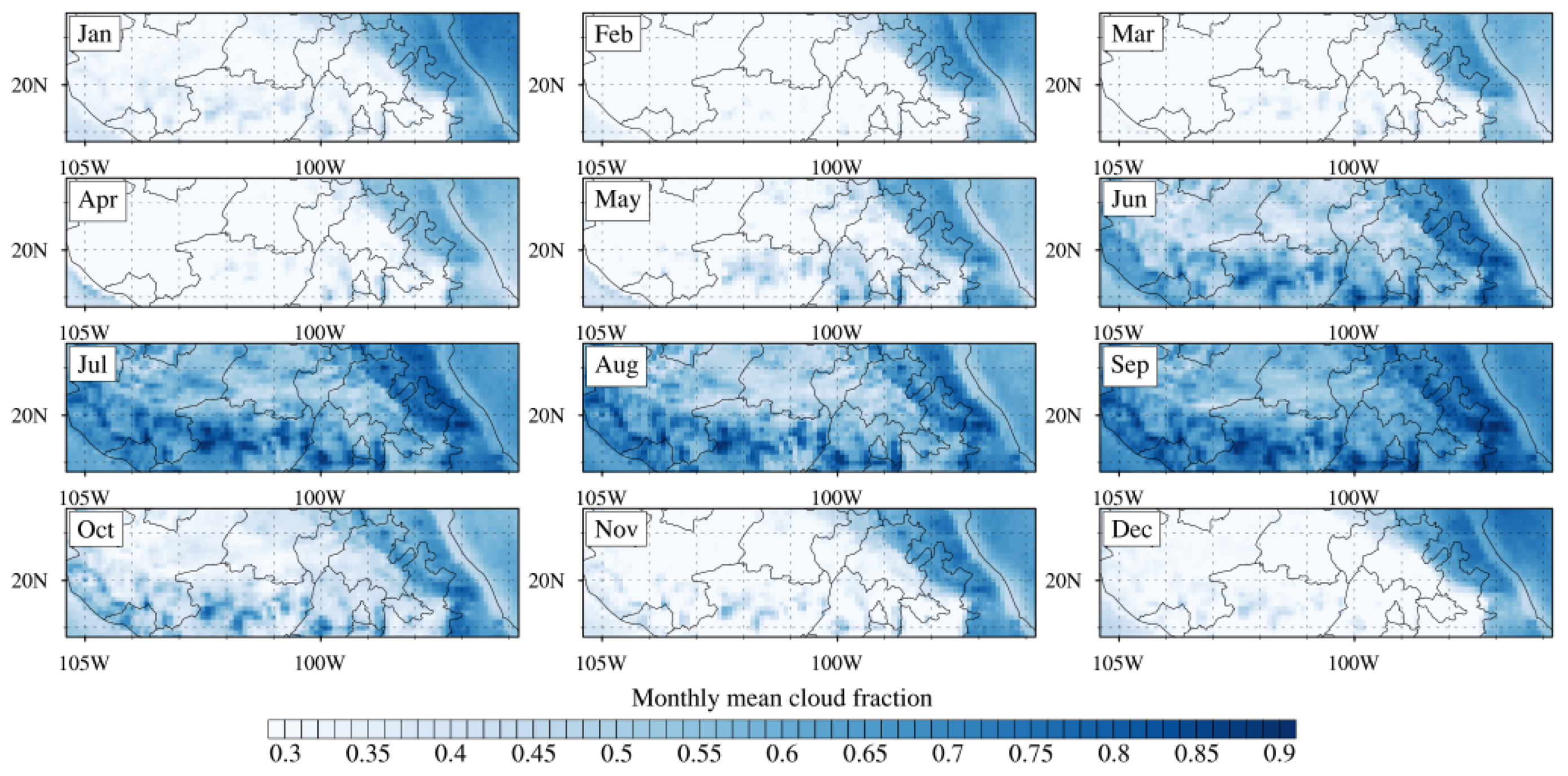
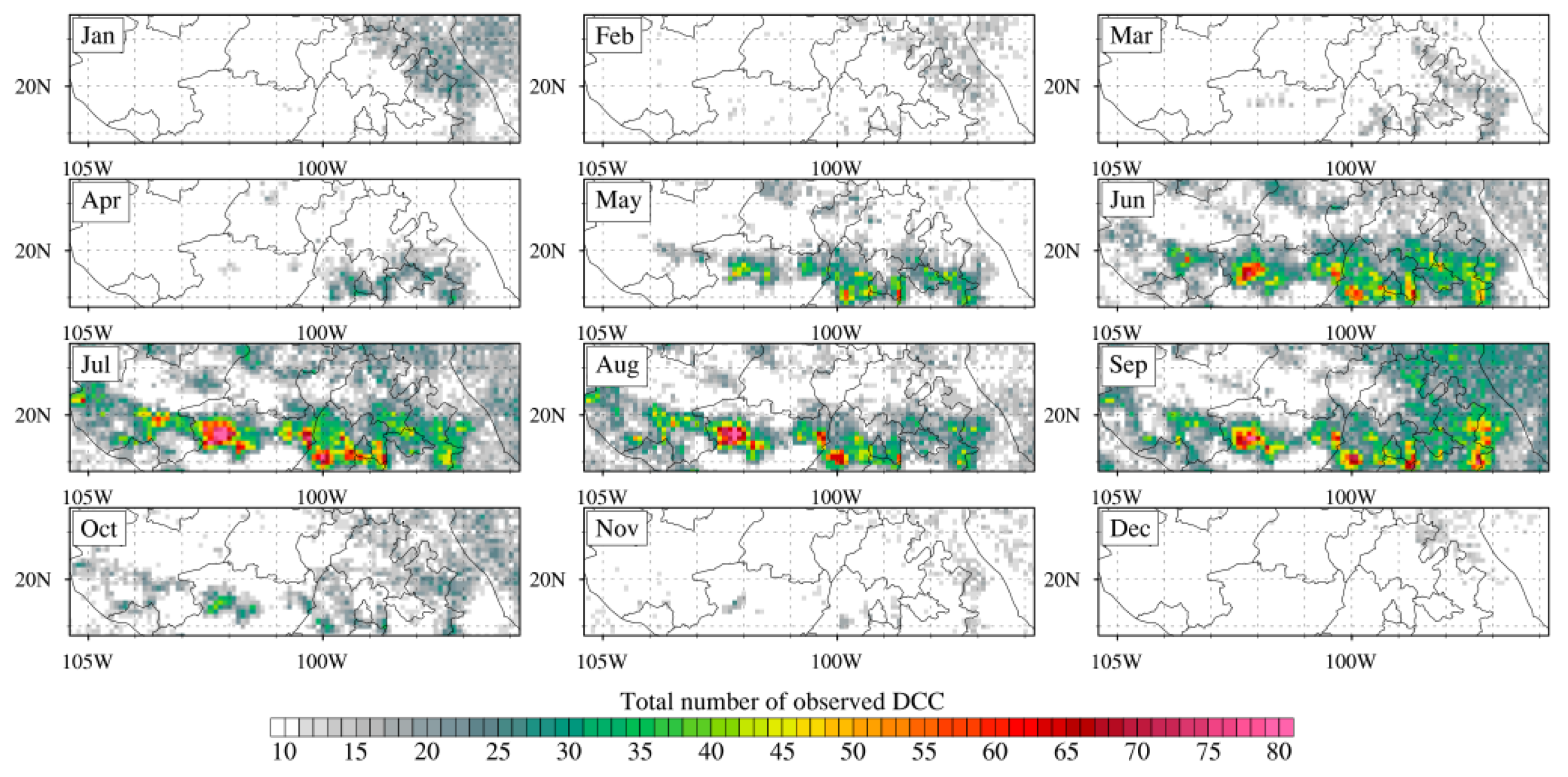
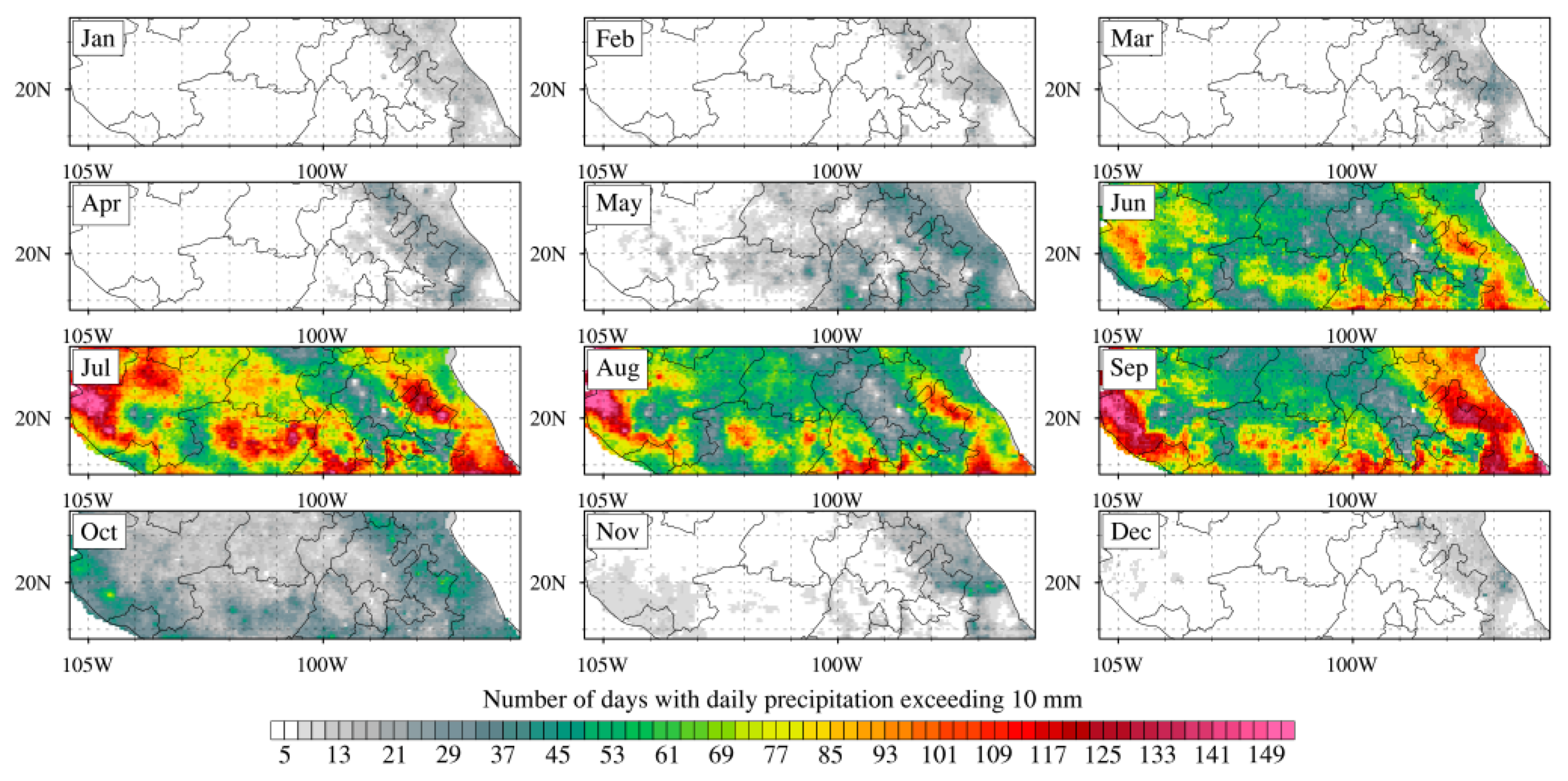

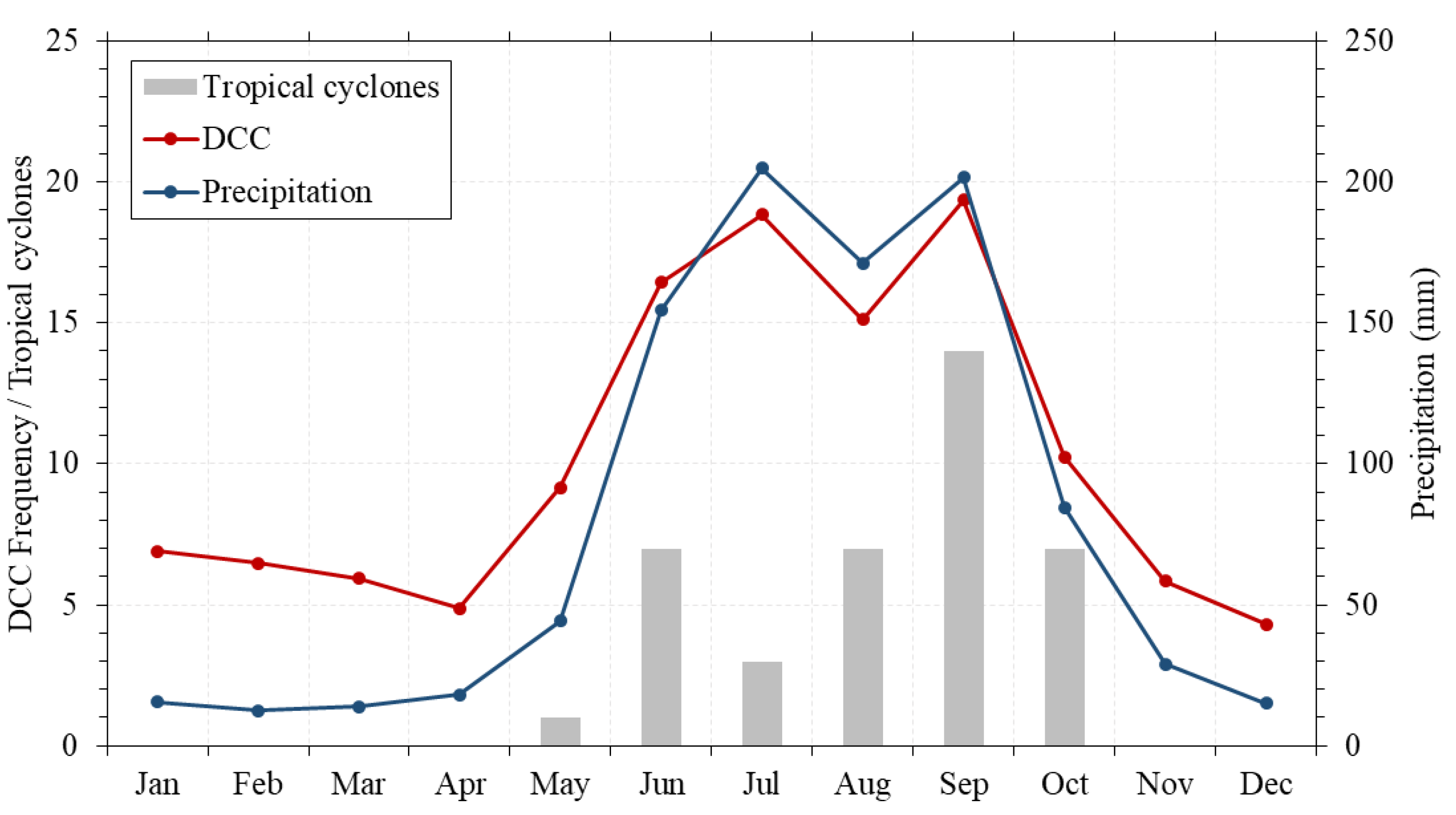
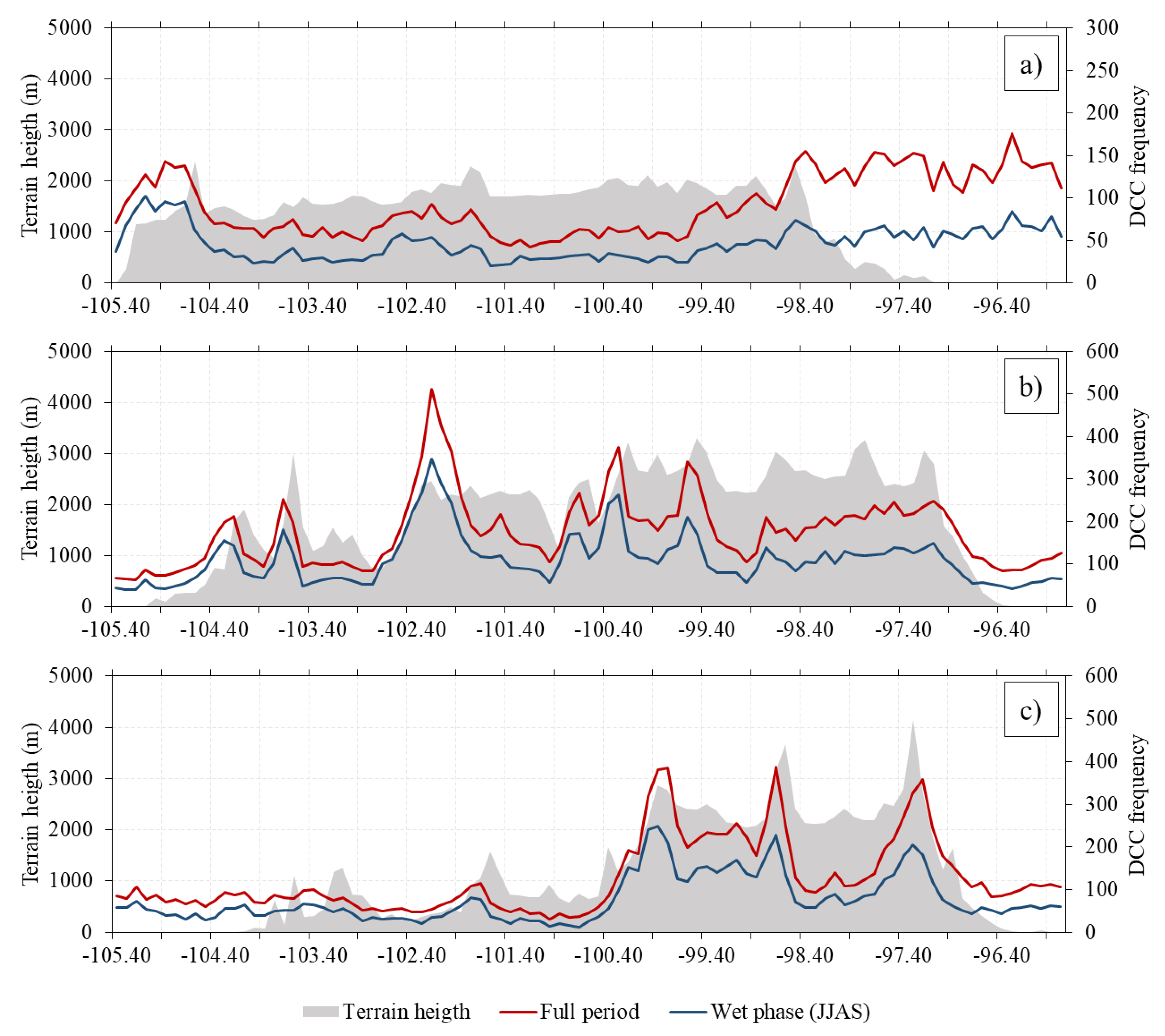
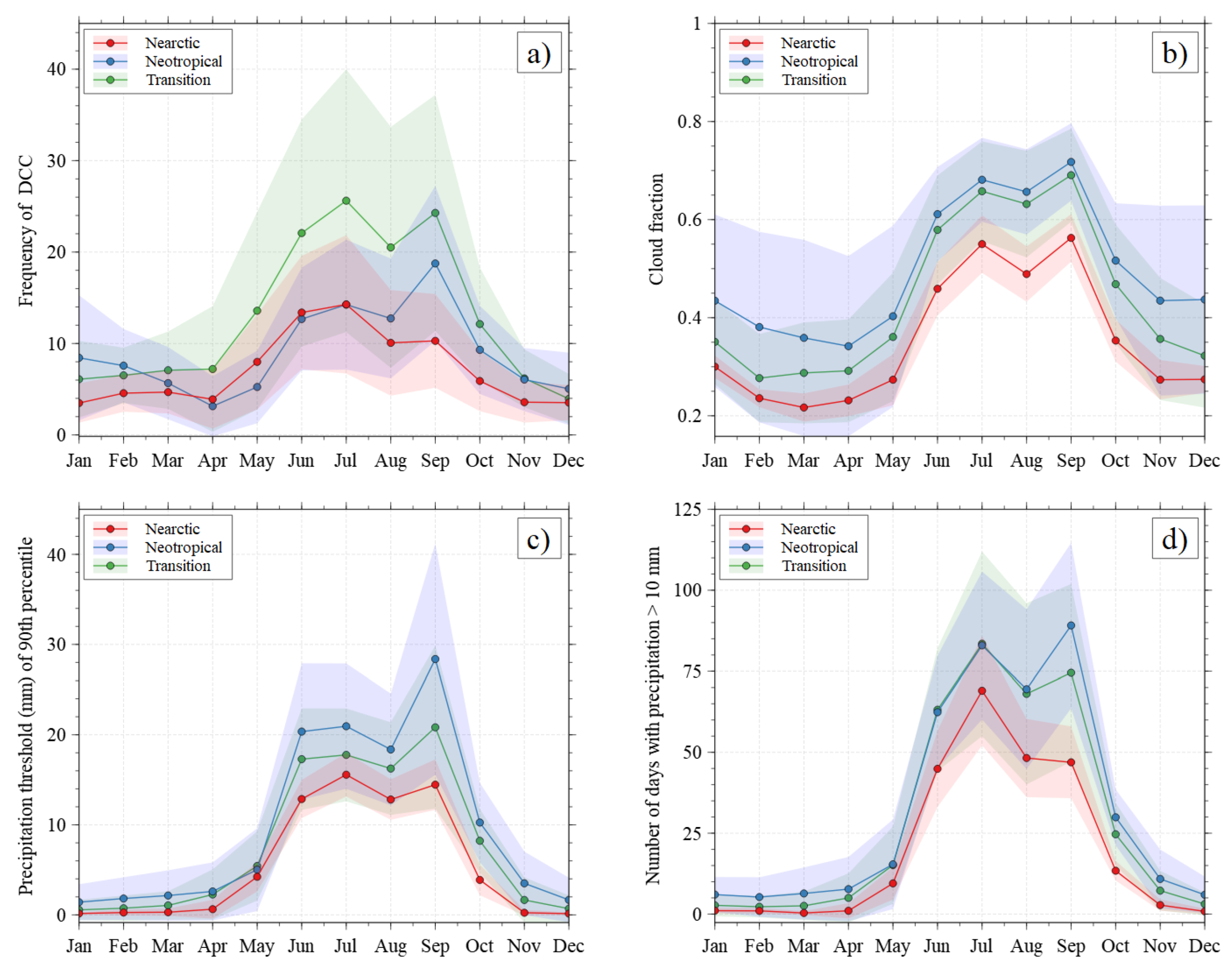
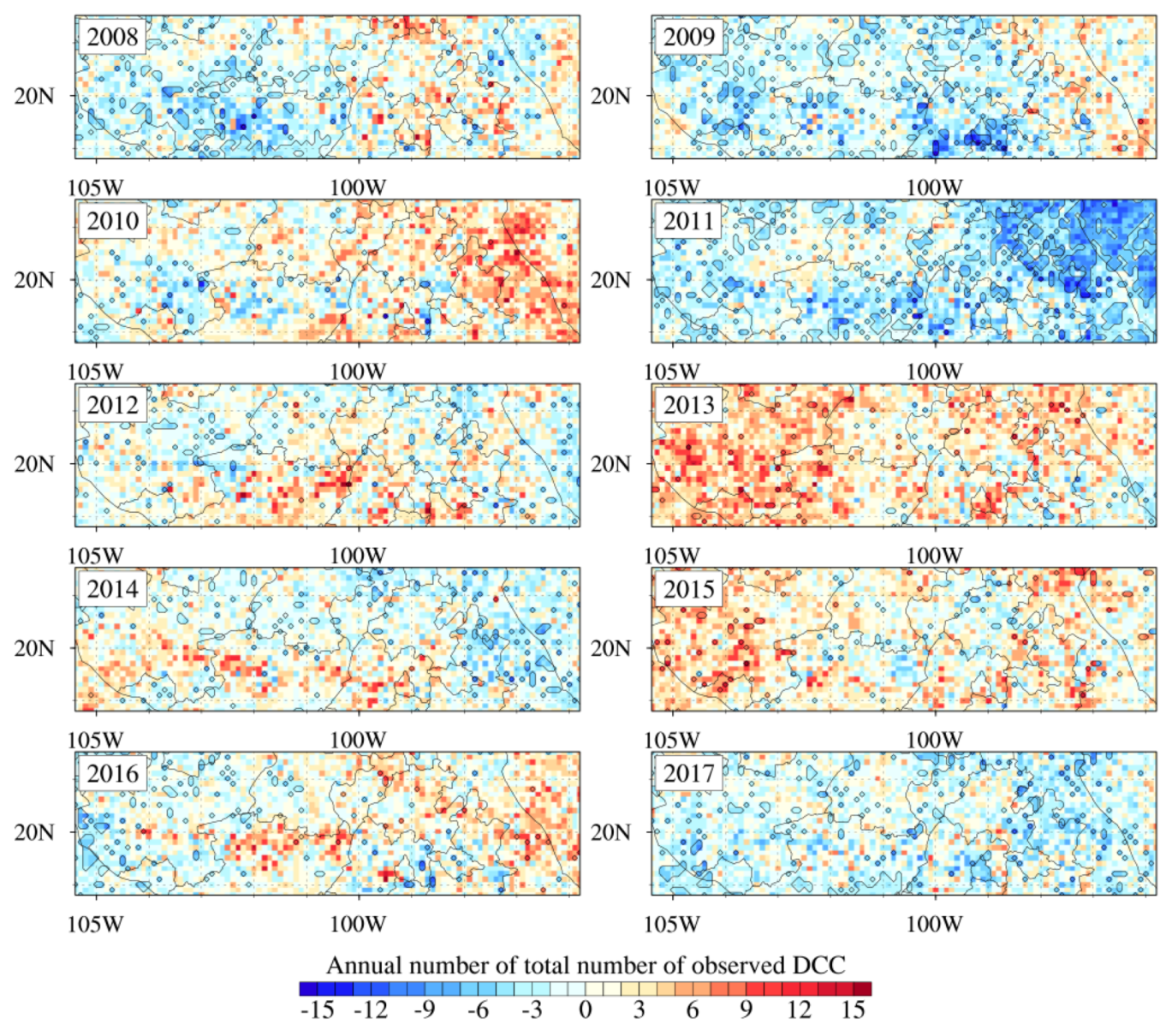
Publisher’s Note: MDPI stays neutral with regard to jurisdictional claims in published maps and institutional affiliations. |
© 2021 by the authors. Licensee MDPI, Basel, Switzerland. This article is an open access article distributed under the terms and conditions of the Creative Commons Attribution (CC BY) license (http://creativecommons.org/licenses/by/4.0/).
Share and Cite
León-Cruz, J.F.; Carbajal Henken, C.; Carbajal, N.; Fischer, J. Spatio-Temporal Distribution of Deep Convection Observed along the Trans-Mexican Volcanic Belt. Remote Sens. 2021, 13, 1215. https://doi.org/10.3390/rs13061215
León-Cruz JF, Carbajal Henken C, Carbajal N, Fischer J. Spatio-Temporal Distribution of Deep Convection Observed along the Trans-Mexican Volcanic Belt. Remote Sensing. 2021; 13(6):1215. https://doi.org/10.3390/rs13061215
Chicago/Turabian StyleLeón-Cruz, José Francisco, Cintia Carbajal Henken, Noel Carbajal, and Jürgen Fischer. 2021. "Spatio-Temporal Distribution of Deep Convection Observed along the Trans-Mexican Volcanic Belt" Remote Sensing 13, no. 6: 1215. https://doi.org/10.3390/rs13061215
APA StyleLeón-Cruz, J. F., Carbajal Henken, C., Carbajal, N., & Fischer, J. (2021). Spatio-Temporal Distribution of Deep Convection Observed along the Trans-Mexican Volcanic Belt. Remote Sensing, 13(6), 1215. https://doi.org/10.3390/rs13061215






